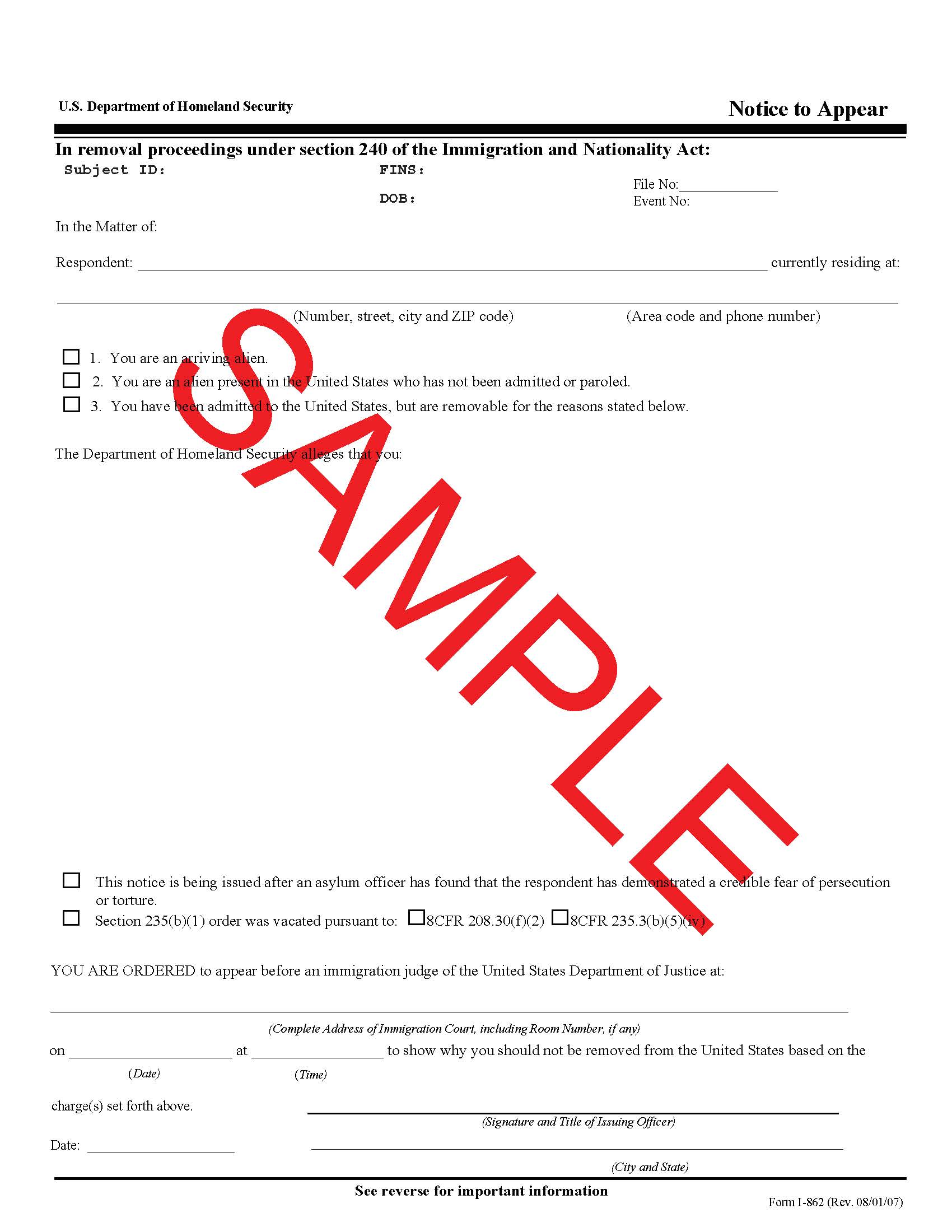
Whether you are planning to stay in Chicago or move to another city, we hope that the information on this page will be helpful. The information here should not be considered legal advice, and is not an exhaustive guide. It is simply a good starting point to getting settled into Chicago.
We recommend looking for other trustworthy sources of information, especially ones local to where you plan to stay. You can find a list below.
Download a PDF of NIJC's Spanish-language legal orientation packet
Download information about legal services and clinics
On this page:
- First steps
- Asylum & Temporary Protected Status (TPS)
- Orientation videos
- How to do an ICE digital check-in
- How to report a change of address
- How to change the venue (immigration court) in which your case proceeds
- Know the Difference: Court dates, ICE check-ins, and the Intensive Supervision Appearance Program (ISAP)
- Verify the status of your case with the immigration court
- The Notice to Appear
First Steps:
Generally, you should not assume you have the automatic right to live in the United States. There are further steps, which can include:
- Attending all your appointments and court dates. If you do not attend all your court dates before the immigration court, your absence could result in a deportation order from an immigration judge.
- Inform the government of any changes of address. If you don't update ICE and the immigration court (two separate agencies) of any new address, you may not receive important documents about your next court dates or updates on your case. Not receiving this information can result in a deportation order from a judge, or complications in your immigration case. Learn more about how to change your address here.
When you are more settled, you should:
- Try to find an attorney. If you are going to stay in Illinois, you can use this site to try to find a local attorney.
- Find information about medical, legal, and housing help, among other things.
Asylum & Temporary Protected Status
Many people who qualify for Temporary Protected Status (TPS) may also be afraid of returning to their home countries for reasons that could form an asylum claim. Read about what to consider if you are deciding whether to seek asylum, TPS, or both.
-
Assistance applying for Temporary Protected Status for Venezuelans
Certain nationals of Venezuela who arrived in the United States on or before July 31, 2023 may be eligible to apply for Temporary Protected Status (TPS). Read more about NIJC's legal services for TPS applicants and what documents you will need to apply. -
Help filing an asylum application
People who plan to apply for asylum, arrived in the United States within the past year, and now live in the Chicago area may be eligible to receive assistance completing an asylum application during a free legal workshop hosted by the National Immigrant Justice Center. Learn about these asylum workshops and fill out an eligibility screening form here.
Orientation Videos
Watch these orientation videos for people who have recently arrived to the United States and Illinois.
View additional videos about:
- Parole and ICE checkins
- Immigration court and how to change your address
- Immigration options
- How to find legal help
- Resources available for undocumented people in Illinois
- How to file for a change of venue (immigration court)
How to do an ICE digital check-in
You may have tried to make an appointment with ICE here in Chicago, only to learn that there are no appointments available for months, or at all. If this is the case, and you have instructions to report to ICE, you should send an email before your reporting date to ICEChicagoReporting@ice.dhs.gov with the following information:
- Your name and A number, along with that of anyone else in your family that must also report to ICE
- Your current address
- Your telephone number
Click here for a template email you can copy and paste
It is possible that you won't receive a reply or a confirmation email.
You should not attempt to arrive at the ICE office in person if you do not have an appointment, and do not attempt to use the digital system to make an appointment. This information about digital check-ins is only valid for people living in the Chicago Field Office's Area of Responsibility.
How to report a change of address
- If you have not received a Notice to Appear (NTA)
Follow the instructions for a digital check-in above, but be sure to indicate that you would like to file a change of address.
Send an email to ICEChicagoReporting@ice.dhs.gov with the following information:- Your name and A number, along with those of anyone else in your family that should report to ICE
- Your old address
- Your new address
- Your phone number
You may not receive a reply or email confirmation.
- If you have received an NTA
While you are pursuing your immigration case, you are required to inform the U.S. government if you move to a new address. To do this, you need to file form EOIR-33, Change of Address. (You may also file this form online through EOIR's Respondent Access site.)
Each immigration court has a different address. Look up the court in which your case is being processed to find the correct form.
Read this detailed guide to complete the change of address form.
How to change the venue (immigration court) in which your case proceeds
People who change their address may also need or want to change the venue (immigration court) in which their case appears to a court that is closer to where they are moving. In order to do this, you must file a "Change of Venue Motion."
Read this detailed guide to complete and submit a change of venue motion. It is a good idea to review all the numbered requirements to ensure the form is filled out correctly.
For help completing the “Change of Venue” process, visit the Chicago Immigration Court Helpdesk, which is available Tuesdays and Wednesdays, 8:30 a.m. to 3 p.m., in the "Pro Bono Room" at the Chicago Immigration Court, 55 E. Monroe St, Suite 1500.
The United States government says that until a Motion to Change Venue is granted, the applicant must "appear in all scheduled hearings" at the original court. If you have not received confirmation of the change of venue, it is important to make every effort to appear at your original court date.
Every time you change your address or make any petition to the immigration court, you must also notifiy the Office of the Principal Legal Advisor. When you click on the page, select the state where your immigration case is being processed, and the Office Type, which in this case is "Office of the Principal Legal Advisor." There, you will see the addresses for the immigration offices. You should also mail any copy of a document or petition that you file to the immigration court to that address.
Watch a workshop about how to file for a change of venue (video is in Spanish):
Know the Difference: Court dates, ICE check-ins, and the Intensive Supervision Appearance Program (ISAP)
-
ICE check-ins
An ICE check-in is a meeting with an ICE agent. Generally, these occur once a year in the ICE/ISAP office closest to your address on file. The agent will review the humanitarian reasons why you should not be in custody, and may ask if you have a pending immigration case. If you have a final order of deportation, it is important to get in touch with a lawyer before going to your appointment. If you do not have a final order, there is only a small possibility that ICE will detain you. However, there is always a risk of detention by ICE. In general, it is important to consult an attorney before your appointment. If you do not go to your appointment, ICE can come find you and detain you. It is very important to go to your appointment. -
Intensive Supervisory Appearance Program (ISAP)
The Intensive Supervisory Appearance Program (ISAP) is an alternative to detention. If ICE determines that you are eligible for a bond or to be released on your own recognizance, it is likely that you will be enrolled in ISAP.
ICE hires agents to supervise ISAP participants using a variety of methods, which can include, among others, ankle monitors, phone check-ins, GPS tracking, and unscheduled visits to the homes of participants. The decision to remove an ankle monitor is case-by-case. The immigration judge cannot make decisions about ankle monitoring. You may be able to increase the possibility of ISAP removing your ankle monitor if you comply with all appointments. You do not need an attorney to attend your ISAP check-in. You should always attend your ISAP check-in and registration appointments, not attending may result in your arrest for parole violation.-
If you are enrolled in in-person check-ins, go to the designated location at the designated time and date
-
If you are enrolled in phone check-ins, pick up all ISAPs calls at the designated time and date.
-
If you are enrolled in the phone check ins and you have a smartphone, you may also ask about the use of the ISAP check-in app.
-
-
Court hearing
There are two main types of immigration court hearings that an individual may have. In addition, there are bond hearings, hearings to determine credible fear, and hearings to re-determine credible fear decisions. Here, we will focus on the two principal types:-
Master Calendar Hearings
These are the first type of hearings in the Immigration Court process, and they are public hearings with many different people appearing before the same judge in the same block of time. It is a preliminary hearing in your case. The immigration judge may ask you to confirm your name, address, and may read the accusation pending against you. In your first hearing(s) in immigration court, the most likely outcome is that you will not be removed/deported from the United States. Everything is part of a process, and the first step, which is your first immigration court hearing, does not usually involve deportation. You will not be deported unless you have asked to be deported or you decide not to attend your first court hearing. If you are looking for an extension to find an immigration attorney, prepare your case, or prepare an application for immigration relief, the most likely outcome is that you will not be deported. You have the right to ask the judge for an extension or a "continuance" in your first hearing. It is possible to have more than one "master" hearing or preliminary hearing. If you have more than one preliminary hearing, you should comply with the judge's instructions for the next preliminary hearing. The more continuances you receive, the more difficult it may be for the judge to grant you another one. At the end of the day, the decision to continue the case depends on the judge's discretion. In other words, if you attend your first immigration court hearing and you are simply complying with what you have been asked, you will not be deported in that moment, but it is very important that you look for an immigration attorney, especially if your case has been extended or continued several times. - Individual hearings
If you are eligible to present an application to remain in the United States, you will have an individual hearing, generally with the same immigration judge (although it may be a different judge). In an individual hearing, you will need to present evidence and provide testimony that you are eligible for deportation relief and why you should remain in the United States. The judge may hear your testimony during one or several hearings. The ICE attorney may also present evidence or testimony against you. Likewise, the judge and/or the ICE attorney may ask you questions about your claim. At the end of the hearing, the judge will either approve or reject your petition verbally or in writing. You are always able to appeal the judge's decision if your petition is denied.
-
- Is it possible to have an ICE check in, a court hearing, and an ISAP appointment?
Yes! You can have 3 different appointments. The three are different, as we explained above, and it is important to attend all three. You can also have just an ICE check in, and be waiting for your immigration court date. Every case is different. For this reason, it is important to organize and review your immigration documents, and also ask questions to be sure you don't miss any appointments. It is very important that if you move, you immediately notify the different agencies that you have changed your address. This is a requirement under the law. Every agency is different, and has their own process to notify them about an address change. You should find out with each agency to ensure you meet this requirement. If you do not change your address, you may not receive important mail that could cause you to miss important appointments and may result in your detention or deportation.
Verify the status of your case with the immigration court
There are two ways to access this information: online, or by phone. If you want to use the website, follow these instructions.
Note: everyone can call the phone line for the immigration court. It is an automated service, and calling will not affect the status of your case.
- Call 1-800-898-7180
- Press1 (for English) or 2 (for Spanish)
- Press 1 again
- Dial your A number
- If you entered it correctly, press 1
- If you did not dial it correctly, press 2 and dial the number again
- If you recieve a phone message saying that your case is not yet reported in the court, it means that you have not yet been assigned a hearing date, but there is a possibility that in the future, you will be assigned a date. You should continue calling the hotline at least once a week.
- If you have a court date, the message will begin to spell your name.
- After your full name is spelled, press 1 to obtain the date and time of your hearing, and the name of your judge..
- Remember and write down:
- The date and time of your hearing
- The address of the immigration court
- The name of the judge assigned to your case
- Press 1 if you need the message repeated!
- Remember and write down:
- If you believe a judge has taken a decision on your case, press 3 instead of 1 after your name is spelled and the message will give you information about the decision. If there is information about a decision, contact an attorney immediately.
IT IS VERY IMPORTANT THAT YOU ARE PRESENT IN ALL HEARINGS AND IMMIGRATION COURT DATES, EVEN IF YOU DO NOT HAVE AN ATTORNEY! IF YOU DO NOT APPEAR, THE JUDGE MAY ISSUE AN ORDER OF DEPORTATION!
The Notice to Appear

This document is known as the Notice to Appear. The government uses this notice to explain the reasons why someoe should be deported.
The document above is a sample page, which has not been filled out. The one you have received contains your personal information. Included in this document is a list of facts known as allegations, and each of them appears numbered. These allegations usually include the following information: your country of origin, when you entered the United States, and the time period you were allowed to remain in the United States. In addition, if you have committed any crimes, that information could be included in this document.
Further, the Notice to Appear will inform you of the reasons the Department of Homeland Security believes you should be subject to expulsion from the United States, and under which section of immigration law that belief is based. These reasons, known as charges, can include the following: that you entered the United States without permission, that you stayed in the country past the date of your visa, or that you have committed certain crimes.
During your first hearing, the immigration judge will likely ask you or your attorney if these allegations are true, and if you agree with the charges. At that point, you will have the opportunity to clarify if the NTA has mistakes or not.
IMPORTANT: Note that at the bottom of the NTA, you will see the phrase "YOU ARE ORDERED." This means that your appearance is required before an immigration judge of the Department of Justice. In addition, the date and specific time of your appearance will be listed. You must appear before the immigration court at the address that appears on your NTA at the date and time indicated.
Generally, you should not assume you have the automatic right to live in the United States. There are further steps, which can include:
- Attending all your appointments and court dates. If you do not attend all your court dates before the immigration court, your absence could result in a deportation order from an immigration judge.
- Inform the government of any changes of address. If you don't update ICE and the immigration court (two separate agencies) of any new address, you may not receive important documents about your next court dates or updates on your case. Not receiving this information can result in a deportation order from a judge, or complications in your immigration case. Learn more about how to change your address here.
When you are more settled, you should:
- Try to find an attorney. If you are going to stay in Illinois, you can use this site to try to find a local attorney.
- Find information about medical, legal, and housing help, among other things.

